While Greater China and the USA are the two lions sharing most of the free market’s fine and rare wine in the world today, there is a third lion, perhaps more of a cub when it comes to its wine, but one that already knows how to roar. I try to go to Brazil at least twice a year, as the passion, energy and culture of the Brazilian people is a true joy to share. Of course, it is more joyous when there are bottles of wine on the table, and the most joyous when they are the world’s finest and rarest.
One of my first and dearest friends in Brazil is known as The Ringmaster. The name is self-explanatory, and The Ringmaster once again planted a seed for a tremendous day to grow into one of the most memorable meals I have had all year. The Maestro was our host, a man who loves wine as much as any that I have ever met, and his spectacular apartment in Sao Paulo was the setting for a lunch that went well into the evening.
Each flight was served ‘single blind,’ so we knew the wines, but we did not know the order, and we started with some Champagne, Krug, of course. The first bubbly was my favorite; its nose was tight with dried qualities and a more rusty personality. The Traveling Man admired its ‘awesome acidity,’ and its palate was delicious, with a delectable citric verve to its super fresh style. There were exotic, green fruit flavors with twists of lime here, and this was the most complicated bubbly at the moment. We were all stunned to discover that this was the ‘regular’ 1990 Krug, given that the other two in this flight were Clos du Mesnils. I thought this was the 1988 Mesnil (97).
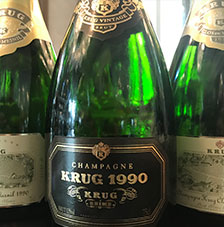
Major Upset
The second Krug in this flight I guessed correctly, with it being a 1990 Krug Clos du Mesnil. There was immediately more oak noticeable in the nose. It had the most power of the flight, but it was a bit dirty and clumsy by comparison to the first Champagne. It was rich and round with soda and cracker qualities, and the vanilla came in as the oak morphed a bit in the glass (95+).
The 1988 Krug Clos du Mesnil was delicious; it was the most ready to go and approachable, which is why I thought it was the 1990 regular. It was quite tasty with citrus and toffee twists, along with pleasant spices and a nice mahogany or interior wood quality. However, it was lighter than the first two! The ’88 has long been one of my favorite Krug vintages, so I was surprised with its more demure personality. It got more limey in the glass (95).
The next flight was all Montrachet and all 1999, featuring DRC, Ramonet and Lafon. Yum. The first Montrachet had a darker color, or a deeper gold I should say. Its buttery nose had lots of spice, great lemon, with a little chiffon to it. Its palate was sweet, rich and round, and its finish felt completely integrated at first. There was a kiss of botrytis for sure. A little food brought out its deep and unfurling acidity, and it kept gaining and gaining in the glass. Ultimately, this 1999 DRC Montrachet was the biggest and baddest in the flight (98).
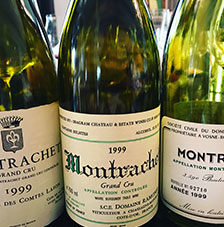
1999 Montrachets
At first, I preferred the 1999 Ramonet Montrachet, whose mintier nose was a giveaway for Ramonet. It felt a lot more wound up and intense than the DRC in the beginning. There was great spice and super spine here, a bit in the S&M direction, as the wine whipped my palate into submission (97).
The 1999 Lafon Montrachet was unfortunately oxidized (DQ), so The Maestro quickly disappeared to his cellar for a mystery white to replace it. He noted ‘sesame’ in the nose, while The Ringmaster found ‘peach marmalade.’ It was leaner than the 1999 and reminded me of the 2000 vintage a bit, but in a much younger way. My guesses were all over the place, and I was thinking older than it really was. The Traveling Man guessed 2009, and he was a lot closer to the actual vintage of this 2012 DRC Montrachet. It was still baby juice compared to the 1999s; I recommend waiting at least ten years before cracking those DRC Montys (94+).
It was on to the red Burgundies, and a classic DRC vs. Leroy showdown. It was easy to see the difference right away, and I correctly guessed the first one being the 1988 DRC Richebourg. There were bright cherry and tomato aromas, along with that good dirt and lots of earth to go with it. There was also some wet fur, in a good way. This was a rich and flavorful red, with chalky flavors and red citrus twits in a limestone way. This was an impressive ’88, and the best ’88 DRC I could remember having. I guess they are finally hitting their stride! There was great tanning expression on its brighter finish (96).
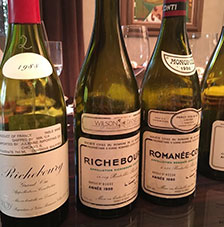
Lucky ‘88s
The 1988 Leroy Richebourg was much richer with a cherry cough syrup thing happening, not in a negative way. It was rich and almost syrupy, oily and long with loads of black fruits on its finish. At first, I found the two Richebourgs qualitatively equal despite being stylistically different (both around 95 points), but after some time in the glass, I agreed with Dr. Feelgood that the DRC was the better wine (94).
We did 1990 and 1978 in the Rhone, Civil War Style, beginning with the South. The first wine was a quintessential Chateauneuf du Pape, with layers of sweet strawberry fruit, hot stones, garrigue, bacon and violets. Its palate was rich, creamy, long and smooth. The 1990 Rayas Chateauneuf du Pape charmed me at first with its sweetness and openness, but ultimately it would succumb to the beast that followed (95).
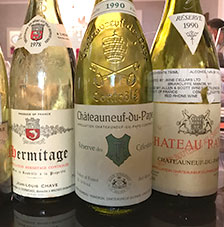
Civil War
Interestingly, the second C du P was a bit yeasty and weird at first. There was this dirty pool water thing as the Rayas giggled its way into my heart. The 1990 Bonneau Chateauneuf du Pape Reserve des Celestins was clearly stronger and blacker; it flexed a lot more muscle and sprinkled a lot of pepper around the nose. Its dirty qualities transformed into oats and cereal, along with a lot of farm goodness. In the end, the Celestins was deeper, longer and more complex (96+).
The North was, as you might guess, a Chave La Chapelle throwdown. The 1978 Chave Hermitage had a sweet and perfumed nose with light pepper, gorgeous violet and whiffs of bacon, all in the right places. This was very classic, very rich and very round (96).
As good as the Chave was, the 1978 Jaboulet Hermitage La Chapelle was one of the wines of the day so far. There was so much animal here with loads of menthol. The was a gamey and meaty wine that was absolutely delicious and oh so good. ‘GREAT’ summed it up (98).
We went to Bordeaux next, and a duo of 1959s. The first had deep fruit that was dark and creamy, with touches of forest, wheat, oat and chocolate. It was blacker than the second, gritty and wheaty with darker hues of fruit. This was a good but not great bottle of 1959 Latour. It’s nice when good can still be 95 points (95).
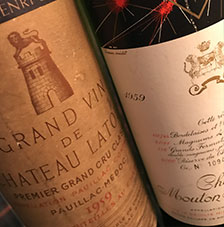
1959 Greatness
The 1959 Mouton Rothschild was stronger and longer, clearly the better bottle. Its cassis, chocolate and mint were divinely proportioned and present. This was a red wine that was actually a cheese killer ”“ usually cheese kills red wines but not this time. This was a classic claret, with that unique Mouton style, in a perfect place (98).
A ‘serious’ blind wine was served next, and the Romanee Conti guesses came quickly. There was this autumnal oil to the nose, along with sweet brown sugar, menthol, gingerbread and more spice. This was a ‘crazy time’ wine. More sweet brown sugar and oats played together nicely on the palate, and this lip smacking red had a citrus spank to its finish that hurt so good. It wasn’t from the 1990s, not 1980s, had to be 1978 RC, I mused. It was a stunningly good bottle of 1988 DRC Romanee Conti. Wow. I was impressed, not only how good, but how much more ready it was than I thought an ’88 would be. I need to investigate a few more from this vintage in early 2018 (98+)!
There were a few epic sweet wines served at the end of this epic lunch, a 1921 Yquem (99), a 1863 Taylor Single Harvest Port (98) and a 1900 Krohn Reserva Port (97), I think. Game, set, match. I was no match for The Maestro, but I am definitely game to try again! I will be seeing him very soon, as a matter of fact”¦
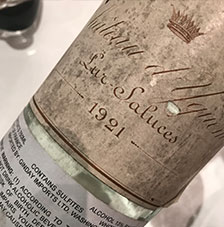
Legend
In Vino Veritas,
JK
